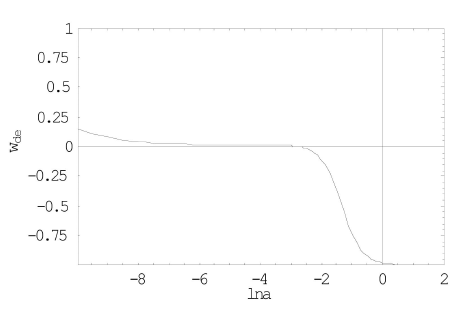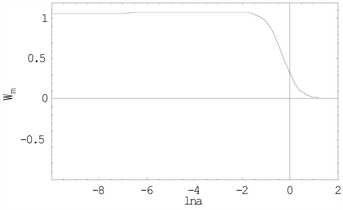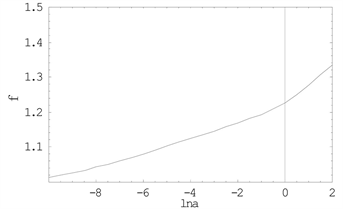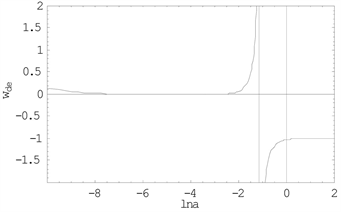Modern Physics
Vol.
08
No.
06
(
2018
), Article ID:
27645
,
6
pages
10.12677/MP.2018.86032
Study on a Kind of Non-Minimal Coupling Dark Energy Models
Xiaofei Zhang
Institute of Science, Binzhou University, Binzhou Shandong

Received: Oct. 30th, 2018; accepted: Nov. 14th, 2018; published: Nov. 21st, 2018

ABSTRACT
This paper studies a kind of non-minimum coupling dark energy models. In the dark energy models, the coupling form of the dark energy as a scalar field and gravity is . We studied the characteristics and evolution behavior of the dark energy field, and analyzed the influence of different parameters on the models. Through analysis, it is found that the parameter a plays a key role in the evolution of the model—whether the dark energy always appears as a Quintessence field.
Keywords:Dark Energy, Non-Minimal Coupling
一种非最小耦合暗能量模型的研究
张晓菲
滨州学院,理学院,山东 滨州

收稿日期:2018年10月30日;录用日期:2018年11月14日;发布日期:2018年11月21日

摘 要
本文研究的是一种非最小耦合暗能量模型。在这种暗能量模型中,作为暗能量的标量场与引力的耦合形式为 。我们研究了该暗能量场的特征和演化行为,并分析了选取不同的参数对模型的影响。通过分析,发现参数a对模型的演化有关键性的作用——暗能量是否一直表现为Quintessence场。
关键词 :暗能量,非最小耦合

Copyright © 2018 by author and Hans Publishers Inc.
This work is licensed under the Creative Commons Attribution International License (CC BY).
http://creativecommons.org/licenses/by/4.0/


1. 引言
目前的天文观测数据,如超新星、哈勃、Planck等,对一种具有负压特征的物质:暗能量提供了支持和限制 [1] - [8] 。暗能量和物质、辐射一样,都是宇宙的构成成分之一。并且,伴随着宇宙的膨胀,辐射和物质将在此过程中被稀释,从而在辐射和物质相继占主导地位之后,暗能量最终在宇宙演化中成为主要成分,并最终主导了宇宙的演化。因此,对于暗能量的研究就有了重要的意义。暗能量模型有很多,在本文中,我们研究的是与引力有非最小耦合的标量场暗能量模型。在这类模型中,因为暗能量与引力有非最小耦合作用 [9] - [13] ,而引起了有别于一般传统暗能量模型的演化情况。我们首先分析了一般形式的暗能量模型;然后又选取了一种具体形式为 的耦合形式,与一种指数势能;最后分析了不同的耦合系数对暗能量演化的影响。
2. 一般形式的非最小耦合暗能量模型
对于一般的暗能量场 和引力发生非最小耦合的情况,普遍的拉氏量形式为 [9] :
(1)
因此,与之相对应的作用量为:
(2)
由(1)可得标量场 的运动学方程为:
(3)
其中的“'”代表对标量场 求导。
从(2)中可得:
(4)
为物质和辐射的能动量张量, 表示暗能量的能动量张量,即:
由方程(4),得:
(5)
把(5)代入前面的运动学方程(3)中,最后可得运动学方程:
(6)
公式(6)决定了 的演化。
3. 具体形式为 , 的暗能量模型
以上的推导是适用于一般的非最小耦合暗能量模型的。我们下面具体分析一种 , 的模型 [13] ,并采用势能 ,分析它的特征。
在这种情况下,公式(2)的形式成为:
(7)
这种模型的暗能量能量密度为 [12] :
(8)
压强为:
(9)
暗能量的状态方程为:
(10)
4. 模型演化两种不同情况的分析
根据前面的运动学方程(6),对暗能量场的演化进行数值计算。为了分析耦合系数a的作用,下面的分析选取同一种势能 ,不同的耦合系数 的两种情况。
1) 耦合系数a > 0
根据由于物质和辐射所占的比例为:
为了符合目前的实验数据限制,选取适当的初始条件,并用自然单位制,a = 0.01,m = 6,b = 0.1,使得今天 ,如图1所示。

Figure 1. Percentage of matter and radiation
图1. 物质与辐射占的百分比
在这样的初始条件下,标量场的演化过程为:
图2横坐标为lna,纵坐标为标量场的值。标量场随时间越来越小,势能也随之减小,意味着这种情况下的暗能量场的状态方程一直大于−1,近似于比较普遍的一般暗能量场的行为。

Figure 2. The evolution of
图2. 的演化过程
图3表示暗能量的状态方程w先是跟随辐射,然后跟随物质,最后下降到−1附近,最终状态类似于宇宙学常数。

Figure 3. The state equation w of the dark energy
图3. 暗能量的状态方程参数w
2) 耦合系数a < 0
如果使耦合系数a = −0.01;要使今天的 仍然为30%,如图4。

Figure 4. Percentage of matter and radiation
图4. 物质与辐射占的百分比
需要使m = 7;b = 0.1。
图5中,暗能量场随时间增加,因此势能和能量密度也随宇宙的膨胀而增加。这意味着它的演化过程与前面a = 0.01的情况完全不同。在某个阶段,表现形式类似于phantom场。

Figure 5. The evolution of
图5. 的演化过程
图6是暗能量本身的状态参数w随时间的演化情况,在今天附近,它演化到了−1以下,跟图5暗示的情况是符合的。

Figure 6. The state equation w of the dark energy
图6. 暗能量的状态方程参数w
可以看出,当a取正数时,暗能量场的演化行为先跟随物质和辐射;当物质和辐射被稀释后,暗能量场摆脱前两者的影响,逐渐接近于−1。而当a取负数时,在物质和辐射占比例大时,与a取正数的情况近似;物质与辐射比例变得足够小后,有一种先增加再减小到−1以下的过程。
以上a取正数或负数而导致的两种情况,都在目前的实验允许范围之内 [1] - [8] ,有待于观测的进一步精确。
5. 结论
根据前面的分析,这种非最小耦合暗能量模型的演化过程高度依赖于耦合系数a的选取,如果a大于0,演化情况类似于quintessence暗能量模型;而a小于0,则会有一个从quintessence场演化到phantom场的过程,最后状态方程参数w从下方无限接近于−1。这两种完全不同的情况给模型的演化提供了多种可能,提高了这类模型的普适性。
文章引用
张晓菲. 一种非最小耦合暗能量模型的研究
Study on a Kind of Non-Minimal Coupling Dark Energy Models[J]. 现代物理, 2018, 08(06): 284-289. https://doi.org/10.12677/MP.2018.86032
参考文献
- 1. Riess, A.G., et al., Supernova Search Team Collaboration. (1998) Observational Evidence from Supernovae for an Accelerating Universe and a Cosmological Constant. Astronomical Journal, 116, 1009-1038.
https://doi.org/10.1086/300499 - 2. Perlmutter, S., et al., Supernova Cosmology Project Collaboration. (1999) Measurements of Omega and Lambda from 42 High Redshift Supernovae. Astronomical Journal, 517, 565-586.
https://doi.org/10.1086/307221 - 3. Tonry, J.L., et al., Supernova Search Team Collaboration. (2003) Cosmo-logical Results from High-z Supernovae. Astronomical Journal, 594, 1-24.
- 4. Riess, A.G., et al., Supernova Search Team Collaboration. (2004) Type Ia Supernova Discoveries at z > 1 from the Hubble Space Telescope: Evidence for Past Deceleration and Constraints on Dark Energy Evolution. Astronomical Journal, 607, 665-687.
https://doi.org/10.1086/383612 - 5. Clocchiatti, A., et al., The High Z SN Search Collaboration. (2006) Hubble Space Telescope and Ground-Based Observations of Type Ia Supernovae at Redshift 0.5: Cosmological Implications. Astronomical Journal, 642, 1-21.
- 6. Di Valentino, E. and Melchiorri, A. (2017) First Cosmological Constraints Combining Planck with the Recent Gravitational-Wave Standard Siren Measurement of the Hubble Constant. e-Print: arXiv:1710.06370.
- 7. Ooba, P., Ratra, B. and Sugiyama, N. (2018) Planck 2015 Constrains on Spatially-Flat Dy-namical Dark Energy Models. Arxiv:1802.05571v1[astro-ph.CO].
- 8. Aghanim, N., et al. (2018) Planck 2018 Results. VI. Cosmological Parameters. Arxiv:1807:06209V1[astro-ph.CO].
- 9. Berti, E., et al. (2015) Testing General Relativity with Present and Future Astrophysical Observations. Classical and Quantum Gravity, 32, 243001-243179.
https://doi.org/10.1088/0264-9381/32/24/243001 - 10. Ooba, J., Ichiki, K., Chiba, T. and Sugiyama, N. (2017) Cosmological Constraints on Scalar-Tensor Gravity and the Variation of the Gravitational Constant. Progress of Theo-retical and Experimental Physics, No. 4, 043E03-043E18.
https://doi.org/10.1093/ptep/ptx046 - 11. Zhang, X.-F. (2017) Evolution of the Universe in Scalar-Tensor Gravity. Modern Physics, 7, 242-248.
https://doi.org/10.12677/MP.2017.76028 - 12. Zhang, X.-F. (2011) Dark Energy Model with Non-Minimal Coupling and Cosmological Constant Boundary. Communications in Theoretical Physics, 56, 1167-1170.
https://doi.org/10.1088/0253-6102/56/6/34 - 13. Torres, D.F. (2002) Quintessence, Super Quintessence and Ob-servable Quantities in Brans-Dicke and Non-Minimally Coupled Theories. Physics Review, D66, Article ID: 043522.
https://doi.org/10.1103/PhysRevD.66.043522